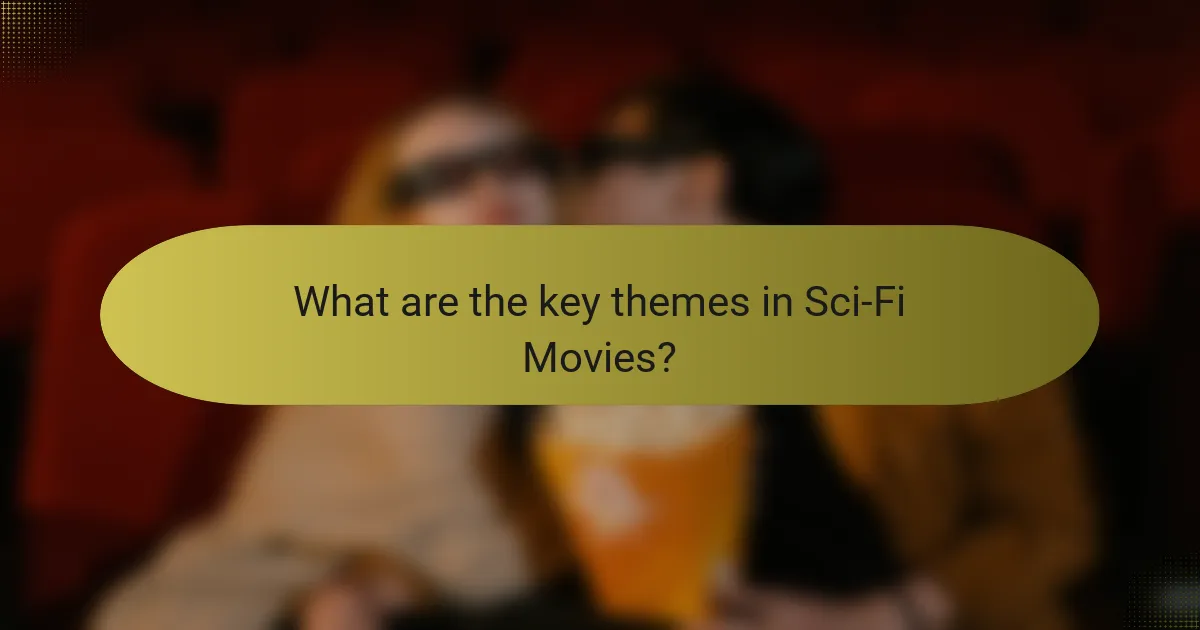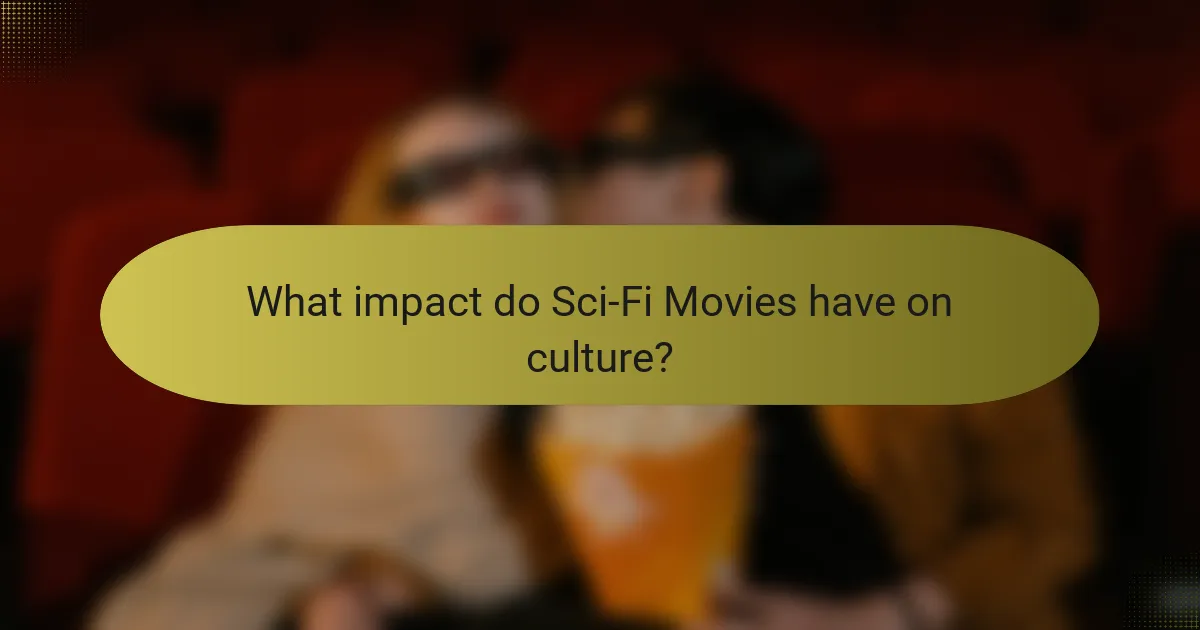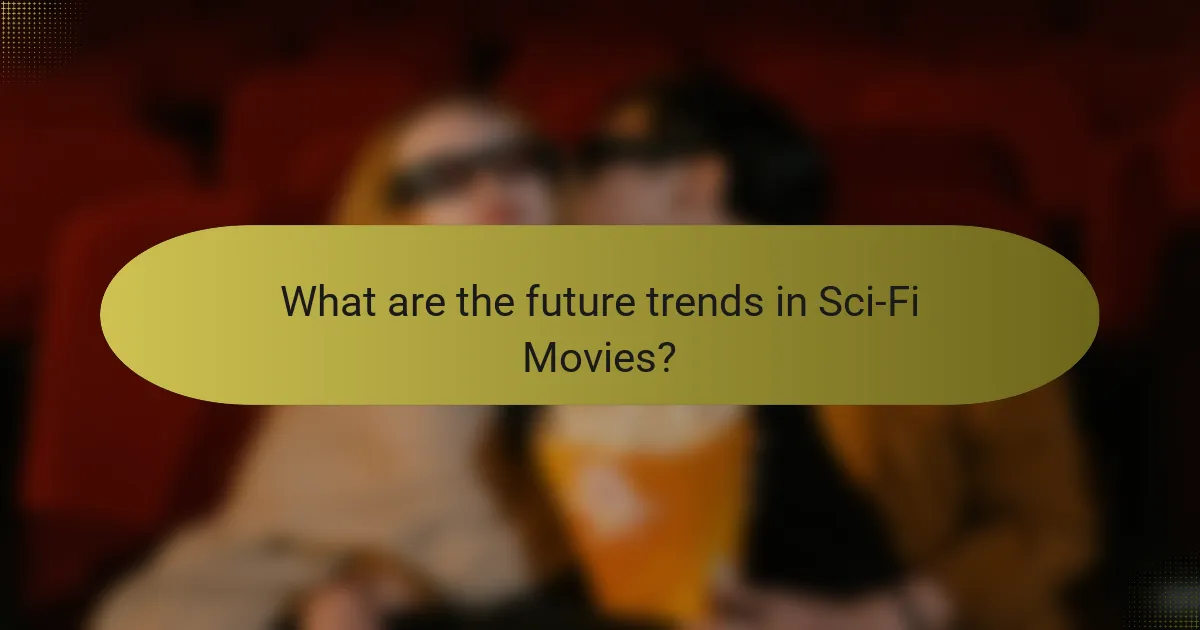The article provides an in-depth analysis of sci-fi movies, focusing on key themes such as technology, artificial intelligence, and the nature of humanity. It examines how these films depict futuristic societies, moral dilemmas, and societal breakdowns, while also exploring concepts like time travel and alien encounters. Additionally, the article discusses the cultural impact of sci-fi, highlighting its role in shaping perceptions of technology and inspiring real-world innovations. Future trends in the genre, including the influence of streaming platforms, increased diversity, and advancements in visual effects, are also outlined, reflecting changing audience preferences and technological developments.

What are the key themes in Sci-Fi Movies?
Key themes in sci-fi movies include exploration of technology, the impact of artificial intelligence, and the nature of humanity. These films often depict futuristic societies and advanced technology. They frequently address moral and ethical dilemmas associated with scientific advancements. Common narratives involve space exploration and alien encounters. Dystopian futures are also a prevalent theme, showcasing societal breakdowns. Additionally, many sci-fi movies explore time travel and its consequences. The genre often reflects contemporary societal fears and hopes. This thematic diversity contributes to the genre’s popularity and relevance.
How do Sci-Fi Movies explore futuristic concepts?
Sci-Fi movies explore futuristic concepts by presenting imaginative scenarios based on advanced technology, space exploration, and societal evolution. They often depict worlds where artificial intelligence and robotics play significant roles. Films like “Blade Runner” examine the implications of genetic engineering and identity. Others, such as “Interstellar,” explore time travel and its effects on human relationships. Sci-Fi narratives frequently use dystopian settings to critique contemporary issues, such as climate change or authoritarianism. The genre encourages audiences to reflect on the potential consequences of scientific advancements. By blending fiction with scientific possibilities, these films stimulate discussions about the future.
What are common futuristic technologies depicted in Sci-Fi Movies?
Common futuristic technologies depicted in sci-fi movies include artificial intelligence, virtual reality, and space travel. Artificial intelligence often appears as sentient robots or advanced computer systems. Movies like “Blade Runner” and “Ex Machina” explore AI’s implications on society. Virtual reality is showcased in films such as “The Matrix,” where characters experience immersive digital worlds. Space travel features prominently in classics like “2001: A Space Odyssey,” highlighting interstellar journeys and advanced spacecraft. Other technologies include time travel, teleportation, and advanced robotics. These concepts reflect humanity’s aspirations and fears regarding technology’s future. Sci-fi films frequently use these technologies to explore ethical dilemmas and societal changes.
How do these technologies reflect current societal trends?
Technologies in sci-fi movies reflect current societal trends by mirroring contemporary concerns and aspirations. For instance, advancements in artificial intelligence in films highlight society’s fascination with automation and ethics. The portrayal of virtual reality aligns with the growing interest in immersive experiences. Renewable energy technologies depicted in these films resonate with current environmental awareness and sustainability efforts. Additionally, themes of surveillance and privacy in sci-fi reflect public discourse on data security and personal freedoms. These representations serve as a commentary on societal anxieties and hopes, showcasing how fiction can influence and predict technological adoption and cultural shifts.
Why are classic films essential to the Sci-Fi genre?
Classic films are essential to the Sci-Fi genre because they established foundational themes and narratives. These films introduced concepts like space exploration, time travel, and dystopian futures. Notable examples include “Metropolis” (1927) and “2001: A Space Odyssey” (1968). They pushed the boundaries of special effects and storytelling. Their influence can be seen in modern Sci-Fi films. Classic films shaped audience expectations and genre conventions. They provided a cultural context for future filmmakers. The legacy of these films continues to inspire new generations.
What defines a classic Sci-Fi film?
A classic Sci-Fi film is defined by its exploration of futuristic concepts and advanced technology. These films often feature imaginative settings that challenge the boundaries of reality. They typically include themes of space exploration, time travel, and the impact of science on society. Classic Sci-Fi films often provoke thought about ethical dilemmas and human existence. Iconic examples include “2001: A Space Odyssey” and “Blade Runner.” These films are recognized for their innovative visual effects and storytelling techniques. They have influenced the genre and inspired future filmmakers. Their cultural significance is often reflected in critical acclaim and enduring popularity.
How have classic Sci-Fi films influenced modern cinema?
Classic Sci-Fi films have significantly influenced modern cinema through their innovative storytelling and visual effects. Films like “Metropolis” and “2001: A Space Odyssey” set standards for narrative structure and thematic depth. They introduced complex characters and moral dilemmas that resonate in contemporary storytelling. The use of groundbreaking special effects in these classics paved the way for today’s CGI technology. Iconic designs and futuristic concepts from classic films continue to inspire filmmakers. For example, “Blade Runner” influenced the cyberpunk genre, seen in films like “The Matrix.” Additionally, classic Sci-Fi’s exploration of societal issues remains relevant in modern narratives. Overall, the legacy of classic Sci-Fi films shapes the creative landscape of modern cinema.
Who are the most influential directors in Sci-Fi cinema?
The most influential directors in Sci-Fi cinema include Stanley Kubrick, Ridley Scott, and George Lucas. Stanley Kubrick directed “2001: A Space Odyssey,” which set new standards for visual effects and storytelling. Ridley Scott is known for “Blade Runner,” which shaped the cyberpunk genre and influenced future films. George Lucas created the “Star Wars” franchise, revolutionizing special effects and world-building in cinema. Other notable directors include James Cameron, who directed “The Terminator,” and Steven Spielberg, known for “Close Encounters of the Third Kind.” Each of these directors has left a lasting impact on the Sci-Fi genre, shaping its evolution and cultural significance.
What are the signature styles of notable Sci-Fi directors?
Notable Sci-Fi directors exhibit distinct signature styles that define their films. Ridley Scott is known for his atmospheric world-building and dark aesthetics, as seen in “Blade Runner.” Stanley Kubrick’s meticulous attention to detail and philosophical themes are prominent in “2001: A Space Odyssey.” James Cameron blends action with innovative technology, exemplified in “Terminator 2: Judgment Day.” Christopher Nolan employs non-linear storytelling and complex narratives, as demonstrated in “Inception.” George Lucas revolutionized special effects and storytelling with the “Star Wars” saga. Each director’s unique approach has shaped the Sci-Fi genre significantly.
How have these directors shaped the genre’s evolution?
These directors have significantly shaped the evolution of the sci-fi genre through innovative storytelling and visual techniques. For instance, Stanley Kubrick’s “2001: A Space Odyssey” set a new standard for visual effects and narrative complexity. Ridley Scott’s “Blade Runner” introduced themes of identity and humanity, influencing countless films. James Cameron’s “Terminator” series blended action with sci-fi, expanding the genre’s appeal. Directors like Steven Spielberg brought emotional depth to sci-fi with films like “E.T.,” making it accessible to wider audiences. Their contributions have established foundational tropes and pushed technological boundaries in filmmaking. This evolution has created a rich tapestry of narratives that continue to inspire new generations of filmmakers.

What impact do Sci-Fi Movies have on culture?
Sci-Fi movies significantly impact culture by shaping societal perceptions of technology and the future. They often explore complex themes like ethics, identity, and humanity’s place in the universe. For instance, films like “Blade Runner” and “The Matrix” challenge viewers to consider the implications of artificial intelligence and virtual reality. These narratives can influence public discourse on technological advancements. Research indicates that Sci-Fi can inspire real-world innovations. Notable inventions like the mobile phone were inspired by Sci-Fi concepts from shows like “Star Trek.” Additionally, Sci-Fi movies often reflect cultural anxieties and aspirations, serving as a mirror to societal issues. Their influence extends to fashion, language, and even political movements, demonstrating their pervasive role in shaping contemporary culture.
How do Sci-Fi Movies reflect societal concerns?
Sci-Fi movies reflect societal concerns by addressing contemporary issues through futuristic narratives. They often explore themes like technology, war, and environmental change. For instance, films like “Blade Runner” highlight the ethical implications of artificial intelligence. “The Matrix” critiques the impact of technology on human freedom. These films serve as cautionary tales about potential futures shaped by current societal choices. Historical events, such as the Cold War, have influenced the themes in Sci-Fi, as seen in “Dr. Strangelove.” Additionally, societal fears about climate change are depicted in movies like “Interstellar.” Sci-Fi acts as a mirror, revealing societal anxieties and encouraging critical reflection on our present.
What themes in Sci-Fi Movies address contemporary issues?
Themes in Sci-Fi movies that address contemporary issues include climate change, social inequality, and technological ethics. Climate change is often depicted through dystopian futures, showcasing the consequences of environmental neglect. Social inequality is explored through narratives that highlight class struggles and systemic oppression. Technological ethics examines the moral implications of artificial intelligence and surveillance. Films like “Blade Runner” and “The Matrix” illustrate these themes effectively. These movies provoke thought about real-world challenges, making them relevant to current societal debates.
How do audiences respond to these representations?
Audiences often respond to representations in sci-fi movies with a mix of fascination and critical analysis. They are drawn to futuristic concepts and imaginative storytelling. Viewers frequently express excitement about the technological innovations depicted. This engagement can lead to discussions about the implications of such advancements. Audiences may also critique the accuracy of representations against current scientific understanding. Emotional responses to character arcs and narratives can enhance viewer investment. Research indicates that audiences appreciate films that challenge their perceptions of reality. A study by the University of Southern California found that sci-fi films that incorporate social commentary resonate more deeply with viewers.
Why do Sci-Fi Movies inspire technological advancements?
Sci-Fi movies inspire technological advancements by presenting imaginative concepts that stimulate innovation. They often depict futuristic technologies that capture the public’s imagination. This can lead to increased interest in scientific research and development. For example, the communicators in “Star Trek” inspired the creation of flip phones. Additionally, films like “The Matrix” influenced advancements in virtual reality. The portrayal of artificial intelligence in movies has driven research in AI technology. Sci-Fi serves as a platform for exploring potential future technologies. This genre encourages both creators and scientists to think beyond current limitations.
What innovations have been inspired by Sci-Fi narratives?
Innovations inspired by Sci-Fi narratives include numerous technological advancements. Examples are mobile phones, which resemble communicators from “Star Trek.” The concept of virtual reality was popularized by “The Matrix.” Artificial intelligence has roots in stories like Isaac Asimov’s “I, Robot.” Robotics has advanced due to visions in films like “Blade Runner.” Space exploration technologies draw inspiration from “2001: A Space Odyssey.” These innovations demonstrate the profound impact of Sci-Fi on real-world technology.
How do inventors and scientists draw from Sci-Fi concepts?
Inventors and scientists draw from Sci-Fi concepts by using imaginative ideas as inspiration for real-world innovations. Sci-Fi often explores advanced technologies and futuristic scenarios. These narratives stimulate creative thinking and problem-solving. For example, the concept of the mobile phone was influenced by communicators in “Star Trek.” Additionally, technologies like virtual reality and artificial intelligence have roots in science fiction literature. Research indicates that Sci-Fi can enhance scientific literacy and inspire future inventions. A study by the University of Southern California found that exposure to Sci-Fi can lead to increased interest in STEM fields.

What are the future trends in Sci-Fi Movies?
Future trends in sci-fi movies include increased use of artificial intelligence and virtual reality. Filmmakers are exploring themes related to climate change and space colonization. The rise of streaming platforms is changing distribution methods. Audiences are demanding more diverse representation in stories and characters. There is a growing interest in blending genres, combining sci-fi with horror and thriller elements. Technological advancements are enhancing visual effects and storytelling techniques. Data from box office trends indicates a rise in global collaborations in sci-fi productions. These trends reflect evolving audience preferences and advancements in technology.
How is technology influencing the future of Sci-Fi filmmaking?
Technology is significantly influencing the future of Sci-Fi filmmaking by enhancing visual effects and storytelling techniques. Advanced CGI allows filmmakers to create realistic and imaginative worlds. Virtual reality (VR) and augmented reality (AR) are providing immersive experiences for audiences. Filmmakers are using artificial intelligence (AI) for scriptwriting and editing processes. Streaming platforms are changing distribution methods, allowing for diverse storytelling. High-definition formats and 3D technology are elevating visual presentations. Innovations in sound design are enriching the auditory experience. These technological advancements are reshaping audience expectations and industry standards.
What advancements in special effects are shaping Sci-Fi films?
Advancements in special effects are significantly shaping Sci-Fi films. Technologies such as CGI have revolutionized visual storytelling. CGI allows for the creation of realistic environments and creatures that were previously impossible. Motion capture technology enhances character performances by capturing human movements. Virtual reality (VR) is also emerging, providing immersive experiences for audiences. Additionally, advancements in practical effects, like animatronics, continue to blend seamlessly with digital effects. The use of AI in post-production is streamlining editing processes and improving visual quality. These innovations are pushing the boundaries of creativity in Sci-Fi filmmaking.
How is virtual reality changing audience engagement with Sci-Fi?
Virtual reality is transforming audience engagement with Sci-Fi by creating immersive experiences. Users can interact with virtual environments, enhancing storytelling. This technology allows audiences to step into Sci-Fi worlds, making narratives more personal. Research indicates that 80% of users feel more connected to stories in virtual settings. VR encourages active participation, as viewers can influence outcomes. This shift leads to deeper emotional investment in characters and plots. As a result, traditional viewing experiences are evolving into participatory adventures.
What emerging themes are expected in future Sci-Fi Movies?
Emerging themes expected in future sci-fi movies include climate change, artificial intelligence, and social inequality. Climate change narratives will likely explore human adaptability and survival. Artificial intelligence themes may focus on ethical dilemmas and human-AI relationships. Social inequality will address issues of class and access to technology. These themes reflect current global challenges and societal shifts. The rise of eco-science fiction highlights environmental concerns. AI-driven narratives are gaining traction as technology advances. Social commentary in sci-fi remains relevant as inequality persists. These themes will resonate with audiences, influencing future storytelling in the genre.
How might global issues shape future Sci-Fi narratives?
Global issues will increasingly shape future Sci-Fi narratives by reflecting societal concerns and technological advancements. Climate change will likely inspire stories about environmental collapse and humanity’s survival strategies. Social inequality may lead to explorations of dystopian societies and class struggles. Political instability could result in narratives centered on authoritarian regimes or resistance movements. Health crises might drive plots about pandemics and bioengineering. These themes resonate with audiences, making Sci-Fi a platform for discussing real-world challenges. The success of films like “Children of Men” and “Snowpiercer” demonstrates this trend. These narratives engage viewers by merging entertainment with critical social commentary.
What role will diversity and representation play in future Sci-Fi films?
Diversity and representation will play a crucial role in future Sci-Fi films. This shift reflects a broader cultural demand for inclusivity. Audiences increasingly seek stories that resonate with varied experiences. Representation enhances relatability and engagement for diverse viewers. Films like “Black Panther” have demonstrated the commercial success of inclusive storytelling. Studies show that diverse casts can lead to higher box office returns. Moreover, diverse narratives can challenge stereotypes and broaden societal perspectives. The future of Sci-Fi will likely embrace these changes to remain relevant and impactful.
What are some tips for enjoying and analyzing Sci-Fi Movies?
To enjoy and analyze sci-fi movies, start by understanding the themes and concepts presented. Sci-fi often explores futuristic technology, societal issues, and philosophical questions. Pay attention to world-building elements, as they establish the setting and context. Analyze character development to see how individuals respond to the sci-fi environment. Recognize the use of special effects and cinematography, which enhance storytelling. Consider the historical context of the film’s release to understand its impact. Engage with online discussions or critiques to gain diverse perspectives. Watching with a critical eye enhances appreciation and understanding of the genre.
The main entity of the article is Sci-Fi Movies, which encompass various themes, futuristic concepts, and influential directors. The article explores key themes such as technology, artificial intelligence, and societal issues, along with how classic films have shaped the genre’s evolution. It highlights the impact of notable directors like Stanley Kubrick and Ridley Scott, and discusses how Sci-Fi narratives reflect contemporary concerns, inspire technological advancements, and engage audiences. Additionally, the article addresses future trends in the genre, including diversity, representation, and emerging themes related to global challenges.